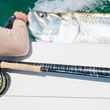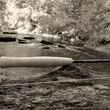How would you like to cast your fly to a fish that might be longer than your fly rod? That’s right, longer than your 9-foot fly rod. If you want an adrenaline rush almost equal to landing on an aircraft carrier, you might want to try a pacific sailfish on fly. You will be close up and personal with your adversary and it’s not as difficult as you might believe. In more than 40 years of fly fishing for Pacific sail, I’ve helped scores of people catch their first. My first was at Club de Pesca de Panama, now called Tropic Star Lodge, in 1964.
Picture this scenario: The Ocean, glassy smooth, as the Pacific often is. The sky, gray and almost threatening, a thunderstorm brewing on the horizon. Your crew has rigged three softhead teasers with the belly-strip from a bonito sewn inside. Suddenly, the tip of a bill appears behind the far teaser. You feel this in your gut; a sailfish is checking out your teaser.
Your captain or mate sees it first and shouts, “He’s coming, he’s coming!" Or, “VELA! VELA!” – “SAIL! SAIL!”
Your David/Goliath adventure is about to begin. In about three seconds, all hell is going to break loose. The sail will grab the teaser, but the mate will snatch it away. Two or three times. Now the sail is mad as hell. That’s when you drop that popper three feet behind its tail.
Before we go any further here, let’s check to make sure your gear is set up to take on that dancing master:
You’ll be ready, with a minimum of two 12 or 13 wt. rods fully rigged with fly reels that hold a minimum of 350 yards of backing – a 13 wt. billfish fly line attached to your backing with a loop-to-loop connection. [Form a loop in your backing with a Bimini twist knot, plus a loop in your fly line, by serving a loop with Kevlar thread or tiny opposing nail knots to form the loop]…or just buy a 13 wt. Cortland Billfish line. I designed this line, 65 feet long with a loop on the back end. It’s a fairly fast-tapered, highly visible floating line, except for the end you’ll attach to the butt section of your leader. The last three feet are intermediate clear mono-core line that will slowly sink.
This fly line, 65 feet long instead of the standard 105 feet increases the amount of backing on your fly reel (your average cast is around 40 feet, seldom, if ever, exceeds 55 feet). It’s important for this fly line to float, so you can pick it up if the sailfish misses your fly, and cast again. It’s equally important to have the last three feet of your fly line slowly sink because 90 percent of the time you’ll be using a popping bug.
To work this, point your rod tip down to the water towards your fly, and vigorously strip line to make the hollowed-out head create a big, burbling sound to attract the sailfish after the teaser is snatched out of the water. A full floating fly line would skip the popping bug out of the water instead of creating a big gurgling sound attracting the fish.

Those who have fished with me or know me are aware of how emphatic I am about having all of your equipment in tip-top condition. Everything should be properly rigged with the fly attached before leaving the dock. This is especially true for this kind of fishing. There were numerous times I’ve had shots at sailfish – even a black marlin – within 20 minutes of leaving the dock.
Now that you have connected your backing to the fly line, here’s the rest of the rig and knots from the fly line down to the hook in your fly.
Sixty pound test monofilament suffices as my butt section, attached to the 12 or 13 wt. fly line with an improved nail knot. A nail knot is easy, provided you follow these instructions: Take the material you are going to use for the butt section of the leader and form a loop. With your right hand place the loop over the end of your fly line. Now hold it with your left-hand, using a round toothpick or something for stiffening the fly line. With your right hand take the right side of the loop and start winding over the top of the fly line and the leader material in the loop. Wind back to your left (away from the end and back over itself) approximately seven turns. Hold all of this between your thumb and first finger of your left-hand and with your right hand slowly pull the end of the leader that is sticking out on the right side, until all the loop is in a straight line off to the right. Now all you have to do is snug up each end … and there you have it.
To turn this into an improved nail knot: Before you start tying it, soak about three inches of the end of your fly line in nail polish remover for about two minutes. Next take a piece of 20-lb. Dacron and tie a couple of overhand knots over the portion that you cured in the nail polish remover. Wrap both ends of the Dacron around your fingers and strip the finish off the fly line. Now you are ready to tie your nail knot over the fly line, leaving the 3 inches of inner core hanging free in front of the nail knot. Very carefully pull up both ends of the formed nail knot, but do not snug it down yet. Slide the knot down to the end of your fly line, still leaving the core hanging free, and snug it up a bit more. Tie an overhand knot using the core, directly around the butt section of the leader where it comes off of the fly line. Snug both ends of the nail knot up tight as well as the overhand knot. Cut off all the loose ends and apply two or three coats of Loon Knot-Sense to protect the nail knot while it’s going in and out of the tiptop and guides. I’ve never had a failure using this connection, with hundreds of fish more than 100 pounds.
The butt section on my billfish rigs are about 2 feet long, including the loop knot at the end. Allow at least a foot of butt section before tying a double surgeon’s loop or a perfection loop. This loop should be at least 3-1/2 inches long, to provide ample clearance when passing one of the big billfish flies, often with tandem 6/0 hooks, through with quickness and ease, even when the bite is on and you’re trying to get a new 4 foot leader section with the fly attached into the action.
Either tie or buy at least a dozen leader sections that have a minimum of 15 inches of class tippet between the knots, with a good connection between the class tippet and the bite tippet (shock tippet). This is done by using one of three different knots that are 100 percent in strength. First tie a Bimini twist creating a double line, before tying either the Albright Knot or the Hufnagel Knot, and the third is the Stu Apte Improved Blood Knot. The other end of this 4 foot leader should have approximately two feet of double line created by a Bimini twist. This end should have a double surgeon’s loop, so you can make the loop to loop connection to the loop in your butt section.

I use a simple three-times-around clinch knot when attaching the 100 pound bite tippet to the eye of the hook, so that all of my bite-tippet-to-fly connections are within a quarter of an inch under the 12 inches allowed by I.G.F.A. for World Record recognition.
My secret for doing this is to put the bite tippet through the eye of the hook, using a ruler. Measure 10 ½ inches making a little crimp in the leader at the eye of the hook. Bring the tag end around three times and go back through the created loop. Lubricate it with a little saliva. This next thing is extremely important: Fold a piece of paper towel approximately three times, and then wrap it around the first finger of your right hand. Make as many turns of 100-lb leader around your finger as you can. Put the first hook, if you’re using a tandem rig, into a U-bolt or cleat. Hold the tag end 90 degrees to the side as you start pulling the knot tight. After the knot is reasonably seated continue pulling with both hands until it is jammed in tight. Holding the tag end to the side prevents putting a little squiggly in your leader near the knot.
Now that your equipment is properly rigged, there are a couple of things to remember when the captain throttles back and the mate puts the teasers over the side. Make sure they have a clean bucket you can put the fly line into that you’re going to cast. Nothing fouls up a good day’s fishing quicker than having someone step on your fly line while it’s on the deck, rolling it under their shoes. In some cases after this happens, the twist in your line may be there forever, leaving it useless to fish with.
Strip approximately 45 feet of fly line from your reel onto the deck, then drop your fly into the water allowing it to drift back to the end of the fly line. You are now able to see how far back your maximum cast will be. This is a good time to stretch your fly line as you are stripping it back into the boat and putting it in the bucket. Three things have occurred. You know how far you can cast, you have stretched the kinks and curls out of the line and you now have the fat part of the fly line that goes through the guides first on top.
Oh yeah, that sailfish we started with? Land that leaper!
































Comments
John Dreyer replied on Permalink
Nice article, good advice especially the intermediate sink tip…but unless you are looking to catch record fish just attach your tippet/ leader …..preferably 100 or 80 lb ….directly to the fly line using loop to loop connection…and a perfection loop to. the fly …the guides will be happy to do it for you since they have learnt most anglers struggle with heavy line knots
Pages